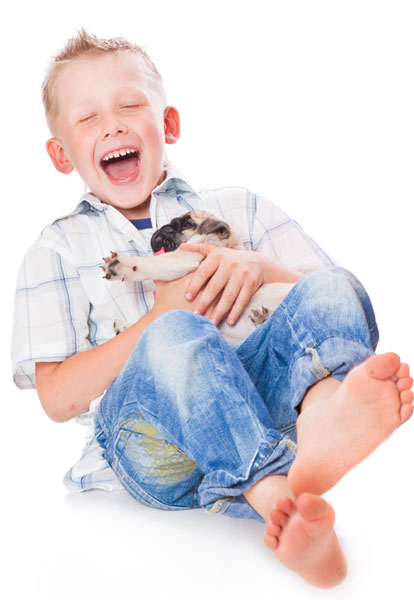If you see this icon in a fact sheet summary you may be dealing with a life threatening issue. Consult a veterinarian immediately.
Use our webform to ask a question or book an appointment

DENTAL DISEASE
The extent of poor oral health in our pets has reached epidemic proportions. By the time they reach the age of three, four out of every five dogs will show some signs of dental disease. We don’t really know how bad the problem is in cats but it’s certainly even more extensive than in dogs.
The good news is that, first, most dental health issues are preventable. You can keep your pet out of the hands of the doggy dentist with some simple home care, and regular annual veterinary dental checks. If your pet already has some degree of oral health problems, caught early enough, they are most likely reversible.
Dental health problems in pets begin with plaque, which is formed by food particles and bacteria collecting along the gumline. Plaque begins to mineralise 3-5 days after it forms. If it is not removed by regular brushing and cleaning, minerals in the animal’s saliva combine with the plaque to form tartar (or calculus) which sticks strongly to the teeth. Tartar irritates the gums and causes gingivitis, an inflammation that can be seen as a reddening of the gums adjacent to the teeth. Gingivitis is what causes your pet to have bad breath. Left untreated, gingivitis will progress to periodontal disease, which is irreversible.
If tartar is not removed it builds up under the gums, separating the gums from the teeth to form ‘pockets.’ These pockets provide an ideal environment for further bacterial growth and more damage to the teeth and gums. Once infection gets into the tooth roots, where it can damage ligaments and bones, your pet has full blown, irreversible periodontal disease (periodontitis) and faces long term health problems. Periodontitis can lead to loose teeth, abscesses, and bone loss or infection and, if bacteria enter the bloodstream, to serious, life threatening heart and kidney disease. Periodontal disease is also always extremely painful for your pet.
Pet carers can prevent the development of serious periodontal disease with simple, regular oral health care at home (see Home Care tab):
- Check your pet’s teeth regularly, including the back teeth.
- Ensure your dog’s diet is suitable, and include raw bones.
- Brush and clean your pet’s teeth at least twice a week.
- Have their teeth scaled and polished once a year at the hospital’s dental surgery.
SEVERITY: Routine to Acute. Can be serious but is almost always treatable.
The first signs of tooth and gum disease are usually:
- Yellow or brown stains on the teeth, indicating a build up of tartar
- Persistent bad breath
- Drooling and dribbling
- Redness of the gums, particularly at the point where the gum meets the tooth, indicates gingivitis
The signs of more serious levels of gum disease include:
- Signs of pus (purulent exudate) around the tooth
- Gums that bleed easily
- Sensitivity around the mouth
- Pawing at the mouth
- Inflamed or receding gums
- Loose or missing teeth
- Loss of appetite
- Stomach or intestinal upsets
- Difficulty chewing or eating
- Irritability or depression
We use a number of criteria to assess the oral health of a dog, including the level and distribution of plaque and tartar, the health of the gums (gingiva), radiologic (x-ray) appearance, and the depth of the gingival sulcus (the ‘pocket’ formed between the tooth and the gum). After assessing these parameters, we can establish the extent and severity of disease and make a prognosis.
Tooth and gum disease are graded according to severity:
Grade I: An animal showing a mild degree of plaque and only minor redness of the gums with no radiologic change is classed as having Early Gingivitis. The prognosis is good, with appropriate treatment able to fully reverse the disease with no lasting effects.
Grade II: Advanced Gingivitis. At this stage, animals will show subgingival (below the gum line) plaque, with oedema and redness of the gums as well as as some radiologic changes. With treatment, the prognosis for full reversal of symptoms remains good.
Grade III: At this stage, the animal will be showing signs of Early Peridontitis. Subgingival calculus will be present, the gums will show redness and edema, some degree of recession (receding gumline) or hyperplasia and will bleed when gently probed. Radiology will show a 10 to 30% loss of bone support. Changes are irreversible and the prognosis is for palliative treatment.
Grade IV: Established Periodontitis will show larger amounts of subgingival calculus, severe inflammation and recession of the gums, pus, loose and/or missing teeth, deep pockets and gums that bleed easily. X-rays will reveal bone losses of greater than 30%. Prognosis is for palliative treatment.
Treatment depends upon the severity (grade) of the disease but in every case your pet will undergo a pre-surgical examination. This may include some pre-anesthetic blood testing to assess their health. In most cases we will also prescribe antibiotics several days before any scheduled dental procedures. Because animals are somewhat reluctant to ‘open wide’ and allow us to poke around in their mouths, your dog must be anaesthetised and monitored during any dental procedure.
Treatment for Grade I or Grade II involves a routine professional prophylaxis (dental cleaning and polishing). Plaque and tartar will be removed from the teeth, above and below the gum line, with handheld and ultrasonic scalers. Each tooth and the entire oral cavity is checked for disease. We will then polish the teeth to remove any microscopic scratches that would otherwise assist plaque formation and tartar build-up.
Following Grade I and II dental procedures we will suggest a regular home care program to control plaque. An individual patient plan might include the removal of plaque through brushing with specially formulated toothpastes, gels and rinses, and a nutrition plan.
Grade III and Grade IV periodontal disease requires more extensive treatment that may include root planing and subgingival curettage, periodontal debridement, gingivectomy, periodontal surgery, special therapeutics, and tooth extraction.
Root planing is a complex and difficult procedure that involves removing residual calculus and diseased cementum or dentin, and smoothing the root surface. Subgingival curettage removes diseased epithelium and connective tissue. This is also a difficult procedure.
An alternative to root planing and gingival curettage is periodontal debridement. In this procedure we use special ultrasonic scalers to remove irritants from the tooth and root surface such as bacteria and endotoxins produced by the bacteria.
In a gingivectomy hyperplastic or excess gingiva is removed. The area between this excess tissue and the tooth is a perfect habitat for bacteria. Periodontal surgery involve opening a flap of the gingiva over the root of the tooth to be able to reach the deeper structures. In some cases, a tooth cannot be saved and extraction is the only alternative.
Home aftercare for pets with Grade III or IV periodontal disease is critical. Pain relief and anti-inflammatory medication will need to be administered post-operatively and for several weeks following the procedures. Antibiotic therapy, usually for one or two weeks after surgery, will also be prescribed. You may also need to apply products containing zinc ascorbate, stannous fluoride, chlorhexidine or plaque preventives to the teeth on a regular basis.
Pets with periodontal disease will need frequent check-ups to assess their continuing oral health. Routine examinations at least twice a year will be needed.
There are a number of things you can do at home to help prevent your dog or cat from ever developing serious oral health issues.
Brush your pet’s teeth regularly, two or three times a week. Yes, it can be difficult if your cat or dog is uncooperative, but they can be trained and regular brushing is the most effective way to reduce plaque and prevent the build-up of tartar.
You can gradually condition your pet to accept brushing by just using your finger, with a little bit of liver paste or something on the tip, to gently rub the outside of the teeth. Gradually replace the paste on your finger with a bit of pet toothpaste and slowly work up to using a brush. We also have finger brushes available, like a thimble with bristles. Many pet carers find these easier to control. It may take a few weeks but eventually your pet will come to accept having their teeth brushed as just part of the routine.
You’ll need a product designed for animals; human toothpaste should not be used because of their foaming action and high levels of fluoride. The taste is also unpalatable to most pets. There are a number of pet pastes and gels available, often flavoured to be acceptable. Only the outside of each tooth needs to be brushed. That rough tongue does a good job of cleaning the inside of the teeth.
Diet is a crucial part of dental care. Some researchers and vets believe that the reduced amount of bones pets get in these days of convenient packaged pet foods may account for the dramatically increased incidence of tooth and gum disease we are seeing in dogs and cats today. Whether that’s true or not, there is no doubt that feeding your dog or cat raw bones a couple of times a week is very beneficial for the health of their teeth and gums. Chewing through bone and cartilage, and tearing the meat off the bone, exercises and cleans the entire tooth, right up to the gum line. Bones must be raw, not cooked.
Bones need to be part of a balanced diet that may include special dental diets for dogs at risk of tooth and gum disease. Contrary to popular belief, feeding your dog exclusively on dry food (or kibble) is no better for their teeth than any good commercial packaged food, wet or dry. The exceptions are the ‘dental’ diet dry foods. The kibble used in these is designed so that your pet has to chew each piece. The structure of the kibble remains intact longer than other dry foods, providing a degree of ‘scrubbing’ against the teeth that helps reduce plaque buildup. Dental foods are also often mildly medicated with chemical plaque cleansers.
The regular use of good quality artificial chews such as ‘Greenies’, which are designed to stimulate natural cleaning of teeth and gums, can also be helpful.
The single most important thing a dog or cat parent can do to keep their pet’s teeth and gums healthy is to schedule an annual dental checkup, and a scale and polish every year. Periodontal disease is painful, irreversible and can be very expensive to treat. There is no need for you or your dog to have to go through it if you get your pet on a good oral health care program now. We are happy to provide free dental checks and to advise you on the best home care plan for your particular pet.
MORE DISEASES OF DOGS
DOGS: ADVICE FOR EMERGENCIES




